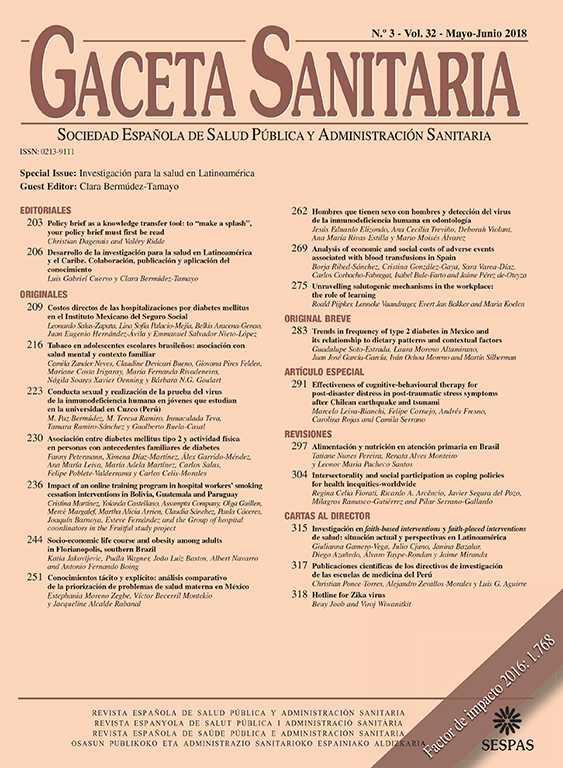Cardiovascular diseases (CVD) are the leading cause of death in low-mortality countries, but subpopulation level differences exist. This study assesses educational inequalities in CVD mortality by sex in Spanish regions (2016-2021).
MethodAge-standardised mortality rates by sex, region and education were estimated using individual-level mortality data from individuals aged ≥35 years residing in Spain provided by the Spanish National Statistics Institute. The Relative and the Slope Indexes of Inequality (RII and SII) were estimated to assess educational inequalities.
ResultsFor the whole Spain, RII was 1.79 (IC95%: 1.42-2.26) for women and 1.59 (IC95%: 1.33-1.91) for men, with differences across regions. The greatest inequalities were found in the Balearic and Canary Islands, and the lowest in La Rioja.
ConclusionsContinued efforts monitoring and tackling cardiovascular morbidity and its determinants are needed at the national and regional level to further contribute to reducing cardiovascular mortality levels and inequalities therein.
Las enfermedades cardiovasculares (ECV) son la principal causa de muerte en los países de baja mortalidad, aunque presentan desigualdades entre subpoblaciones. Este estudio evalúa desigualdades educativas en mortalidad por ECV según el sexo en las regiones españolas (2016-2021).
MétodoSe estimaron tasas de mortalidad estandarizadas por edad, sexo, región y nivel educativo utilizando datos individuales de mortalidad de individuos ≥35 años residentes en España, proporcionados por el Instituto Nacional de Estadística. Se estimaron los índices de desigualdad relativa y de pendiente (RII y SII) para evaluar las desigualdades educativas.
ResultadosPara toda España, el RII fue de 1,79 (IC95%: 1,42-2,26) para las mujeres y de 1,59 (IC95%: 1,33-1,91) para los varones, observándose diferencias entre regiones. Las mayores desigualdades se encontraron en las Islas Baleares y Canarias, y las menores en La Rioja.
ConclusionesEs necesario continuar con los esfuerzos de seguimiento y abordaje de la morbilidad cardiovascular y sus determinantes en los ámbitos nacional y regional para seguir contribuyendo a reducir los niveles de mortalidad por causa cardiovascular y sus desigualdades.
Cardiovascular diseases (CVD) are the leading cause of death in Europe,1 with a disproportionate impact on lower socioeconomic classes.2 Over the last decade, cardiovascular mortality decline has slowed in most low-mortality countries, including Spain.3 Spain represents a particularly interesting case to study cardiovascular mortality patterns as it has one of the lowest levels of CVD mortality in Europe.1 Despite persistent socioeconomic inequalities,4–6 comparative studies suggested these mortality inequalities in Spain to be smaller compared to other low-mortality countries.4,7,8
The scarce evidence on regional differences in CVD mortality are limited to studies for Madrid, Barcelona and the Basque Country and suggest them to be at comparable levels to the aggregated data of other Spanish regions for 2001-2008.9 While these regions have above average life expectancy levels,10 its findings might not represent all existing inequalities. Beyond mortality, a recent work studying well-established CVD risk factors, e.g. diabetes, hypertension or smoking, found that socioeconomic inequalities in cardiovascular risk factors vary across regions,11 which suggests that regional disparities might also exist in socioeconomic inequalities in CVD mortality.
This study aims to enhance our understanding of CVD mortality patterns and socioeconomic inequalities therein in Spain by estimating age-standardised mortality rates and relative and absolute educational inequalities in cardiovascular mortality in Spanish regions.
MethodWe used individual-level mortality data from individuals aged ≥35 years residing in Spain from 2016-2021 provided by the Spanish National Statistics Institute, and the corresponding education-specific mortality rates by age group, sex, and region from the same source. This entailed a total of 711,351 CVD deaths (coded as underlying causes I00-I99 according to the International Classification of Diseases 10th Revision). The dataset included educational attainment, which was grouped into four educational groups: low (primary education or less; International Standard Classification of Education [ISCED] 0–1), medium-low (low secondary education; ISCED 2), medium-high (high secondary education; ISCED 3-4) and high (tertiary or university education; ISCED >5). Education was missing in 10,345 CVD deaths (1.5%). These deaths were proportionally distributed across educational groups according to the proportion of CVD deaths by education for each combination of sex, age (5-year group).
The resulting dataset contained cause-specific death counts and all-cause mortality rates for each group -being each group a combination of sex, age (5-year), education level, and region (autonomous community). We estimated CVD mortality rates by multiplying all-cause mortality rates with the proportion of CVD deaths within all-cause deaths for each group. We standardized mortality rates applying the direct standardisation approach and using the Spanish population of 2019 as the reference population.
Relative educational inequalities were estimated using the relative index of inequality (RII). The RII was estimated using a multivariate quasi-Poisson model adjusted by age to account for overdispersion.12 This measure considers the relative position of each educational group and can be interpreted as the mortality rate ratio between those with low and high education.13 Absolute educational inequalities were estimated using the slope index of inequality (SII), which measures the rate differences between the lowest and highest levels of education.13
By pulling together data across six years we increased the statistical power. In a sensitivity analysis we replicated our results for the pre- and covid-periods (see Tables S1-S2 in Supplementary data), showing no variation in the ranking of regions and providing robustness of our findings.
ResultsThe age-standardised CVD mortality rates in Spain 2016-2021 were 4.74 (95% confidence interval [95%CI]: 4.73-4.76) per 1000 person-year for men and 3.32 (95%CI: 3.31-3.33) per 1000 person-year for women (Figures 1 and 2). For both sexes, Andalucia and Murcia were the regions with the highest mortality rates (>5.24 for men and >4 for women), while Madrid and Navarra were the regions with the lowest mortality rates (<4.25 for men and <2.63 for women).
Age standardised cardiovascular mortality rates (per 1000 persons-years), relative index of inequality and slope index of inequality by autonomous community and educational level, ages 35+, Spain 2016-2021, women. 95%CI: 95% confidence interval; RII: relative index of inequality; SII: slope index of inequality.
Age standardised cardiovascular mortality rates (per 1000 persons-years), relative index of inequality and slope index of inequality by autonomous community and educational level, ages 35+, Spain 2016-2021, men. 95%CI: 95% confidence interval; RII: relative index of inequality; SII: slope index of inequality.
In terms of educational inequalities, the heatmaps embodied in Figures 1 and 2 suggest an educational gradient in CVD mortality across most regions. For the whole country, the RII was 1.59 (95%CI: 1.36-1.87) among men, and 1.79 (95%CI: 1.42-2.26) among women. For both sexes, Canary and Balearic Islands were the regions with the highest relative educational inequalities (RII >1.75 for men and RII >1.90 for women alongside with Extremadura), while La Rioja was the region with the smallest educational inequalities (RII=1.28 [95%CI: 0.97-1.70] for men and RII=1.20 [95%CI: 0.84-1.71] for women). In terms of absolute inequalities, the SII was 2.2 among men, ranging from 1.2 in La Rioja to 3.2 in Balearic Islands. Among women, the SII was 1.9, ranging from 0.6 in la Rioja to 2.8 in Andalucia.
DiscussionEducational inequalities in CVD mortality exists in nearly all Spanish regions, although its magnitude differs across them. Interestingly, our findings suggest that CVD mortality was lower for low educated groups in a low mortality region (e.g. Madrid), compared to high educated groups in a high mortality region (e.g. Andalucia or Murcia).
While our findings on educational inequalities in CVD mortality in Spain are consistent with previous studies,4,5,7–9 the region-specific analyses provided for the first time insights on the regional heterogeneity. Inequalities are low in certain regions (e.g. La Rioja), yet considerable in other regions (e.g. Balearic Islands and Canary Islands). Furthermore, we have confirmed that the regions analysed in previous studies —Madrid, Basque Country and Barcelona—4,7–9 have among the lowest CVD mortality rates and inequalities across the Spanish regions.
The variability in the magnitude of inequalities across regions stems from the interaction between macro- and individual-level factors. On the macro level, previous research has pointed out at income inequalities as a driver of health inequalities across regions.14 This may partly explain our finding of higher inequalities in the Canary Islands and Balearic Islands, which have the highest income inequalities.15 Furthermore, Spain's decentralized healthcare system leads to regional differences in health policies, infrastructure, and resources, contributing to variations in mortality outcomes and inequalities therein across regions.16 On the individual-level, inequalities in CVD mortality across regions may stem from unequal exposure to risk factors, particularly diabetes, hypertension, and tobacco in males.11
Our results suggest slightly higher inequalities in women compared to men, and narrower sex differences as compared to previous studies.5,8,9 Potential explanations for the higher inequalities observed in women compared to men have traditionally been attributed to disparities in risk factors,5,11 and particularly to obesity, hypertension and diabetes.11,17 The narrowed gap found in this study might suggest a trend towards reduced sex gaps in inequalities in CVD risk factors, an underexplored population level issue.
The inequalities estimated in this study point at potential for improvement in terms of ensuring equitable health outcomes for all subpopulation groups, particularly in the regions with highest inequalities. These programs should focus on ensuring equitable healthcare access, improving service provision, and promoting healthy lifestyles to reduce the burden of risk factors such as diabetes and hypertension.
This study is the first one assessing inequalities in CVD mortality across all Spanish regions using high-quality register data. Future studies should examine potential differences across educational groups and regions on the determinants by CVD type (e.g. ischemic heart disease, stroke, hypertensive diseases).
ConclusionsOur findings reinforce the need of continued public health efforts to reduce CVD mortality inequalities within and across regions. Special focus tackling the determinants of CVD, for instance health behaviours or equitable health care access, will contribute to reduce CVD morbidity and mortality levels and inequalities therein.
Availability of databases and material for replicationIndividual level mortality data by educational attainment were obtained from the Spanish National Statistics Institute (INE). These data are not publicy available but interested researchers have the possibility to request access to the data by contacting INE (www.ine.es). R codes used to generate all results can be requested from the corresponding author.
Editor in chargeDavid Cantarero.
Educational inequalities exist in cardiovascular mortality in Spain and certain regions (Basque Country and Madrid).
What does this study add to the literature?Educational inequalities are heterogeneous across regions in Spain. The regions previously studied represent some of the best performing regions. Therefore, previous studies might have underestimated educational inequalities in Spain and its regions. Canary and the Baleric Islands are the regions with the highest educational inequalities, while La Rioja exhibits the lowest inequalities.
What are the implications of the results?Public health interventions are needed, particularly in the regions with highest cardiovascular mortality rates, while tailored policy focused on lower educational groups would benefit regions with highest inequalities.
The corresponding author, on behalf of the other authors guarantee the accuracy, transparency and honesty of the data and information contained in the study, that no relevant information has been omitted and that all discrepancies between authors have been adequately resolved and described.
Authorship contributionsBoth authors contributed significantly to the conception, design, drafting, and revision of the manuscript.
FundingThis study was supported with funding provided by the BBVA Foundation (Beca Leonardo 2023), by the European Research Council (ERC-2019-COG agreement 864616, HEALIN) and by the Spanish Ministry of Science and Innovation (projects PID2021-128892OB-I00 and PID2023-148727OA-I00). S. Trias-Llimós acknowledges research funding from the Ramón y Cajal program of the Spanish Ministry of Science and Innovation (RYC2021-033123-I). E. Pérez-Miguel acknowledges funding from a doctoral fellowship FI-AGAUR (grant: 2024 FI-1 00301), in the framework of the Doctoral Program in Demography at UAB and as member of the Consolidated Research Group on ‘Demography of Health and Ageing’- HEALTHAGE (grant 2021 SGR 01337)
Conflicts of interestNone.


















